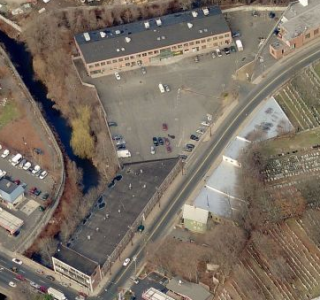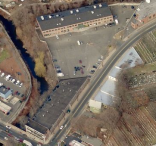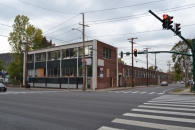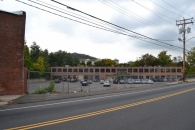Mill Record New Haven
RETURN TO ‘FIND MILLS’Disclaimer: Content for these properties was compiled in 2014-2017 from a variety of sources and is subject to change. Updates are occasionally made under Property Information, however the Connecticut Trust for Historic Preservation (dba Preservation Connecticut) makes no representation or warranty that the information is complete or up-to-date.
- Complex Name (Common)
- Forsyth Dyeing Co. DEMO planned as of 2022
- Complex Name (Historic)
-
- Forsyth Dyeing Co.
- Address or Location
- 781 Whalley Avenue, West New Haven, New Haven
- County
- New Haven
- Historic Designation
- Associated Mill Community
- n/a

- Historic Information
Companies Associated w/Complex
- A. D. Steinbach and Sons ca. 1948-late-20th c.
- Forsyth Dyeing Co. 1912-1924
- Pond Lilly Co. 1924-1928
- Star-Brite Products Co. 1931-1948
Use (Historic)
Largest Documented Workforce
225 (1948).
Historic Narrative
The origins of New Haven, Connecticut’s Forsyth Dyeing Company date to 1868 and the establishment of the firm of Forsyth and Fisher. In 1876, Thomas Forsyth, one of the original partners in Forsyth and Fisher, secured full control of the business, which was incorporated as the Forsyth Dyeing, Laundrying and Bleaching Company in 1887. The Forsyth Dyeing, Laundrying and Bleaching Company conducted all aspects of processing raw and finished textiles and initially maintained a large plant at the intersection of State, Lawrence, and Mechanic Streets in New Haven. The business was moved to Whalley Avenue in 1912, this after the business was reorganized by Thomas Forsyth’s three sons. The family business was reincorporated as the Forsyth Dyeing Company by William H., Lesley E., and Thomas Forsyth in April 1912. A new plant was built at the northwest corner of the intersection of Whalley Avenue and Fitch Street and the original factory was vacated. The Forsyth Dyeing Company continued to operate on Whalley Avenue until 1924 when the business was closed. The plant then passed to the Pond Lily Company, a textile dyeing and processing firm established in New Haven in 1896. The Pond Lily Company operated the Forsyth facility as a supplement to its primary plant, which was located on Whalley Avenue just over a mile to the west until its demolition during the late-20th century. The Pond Lily Company maintained the former Forsyth Dyeing plant until a lull in business forced the firm to contract operations in 1928. The former Forsyth Dyeing plant stood vacant until 1931, whereupon it passed to the Sta-Brite Company, a cutlery manufacturer founded in New Haven as the Hemming Brothers Company in 1904. In 1943, the Sta-Brite Company was acquired by the Ekco Products Company of Byesville, Ohio, which maintained operations at the New Haven factory until 1948. The plant then passed to the New Haven-based lithography and publication firm of A.E. Steinbach and Sons. A.E. Steinbach and Sons occupied the factory as both an office and production facility and such work continued there until 1963 when the firm was bought out by the Printing Corporation of America. After the buyout, the latter company reduced activities in New Haven to those of the office and sales staffs, this continuing into the late-20th century.
- Architectural Information
Number of Existing Buildings
Three (3) primary blocks.
Dates of Construction
1912, ca. 1931.
Architect
n/a
Builder
n/a
Building Type
Architectural Description
The former Forsyth Dyeing Company plant consists of three primary adjoining and freestanding blocks located on the north side of Whalley Avenue, at the northwest corner of Whalley Avenue’s intersection with Fitch Street. Of the three blocks, the most prominent, that fronting on Whalley Avenue, is the most recently constructed. This was erected as an office ca. 1931 and is a two-story, 78’ x 30’ steel-frame building of Modernist styling. The façade is broken into five bays by four full-height steel columns and has concrete and black marble spandrel panels, large ribbon windows with metal sash and hopper-style openings, a concrete panel cornice, concrete panel corner columns, and a flat roof. The primary entry to the block is located on the eastern side of its south (façade) elevation and consists of a metal and glass pass-through door flanked by plate glass sidelight and with a large plate glass transom above. A one-story, 30’ x 298’ red brick block adjoins the north (rear) elevation of the office. This was built as a warehouse in 1912. The building has a raised basement level, segmental-arched window openings with paired sash and brownstone sills, and a flat roof. Three pass-through door openings are placed at various locations along the block’s east (side) elevation. These show signs of originally having been flanked by door surrounds and topped by broken triangular pediments. All of the original doors have been removed and one of the openings has been infilled with brick. The final block associated with the plant stands roughly 250’ north of the warehouse. The large parking lot between the two buildings was once the site of additional factory buildings, these demolished during the late-19th and early-20th centuries. The surviving manufacturing block originally housed dyeing and finishing operations and is a two-story, 248’ x 65’ red brick building with segmental-arched window openings, stone window sills, paired fenestration, and a flat roof. The building has been converted for commercial use and a lobby has been created by inserting a large steel beam between the first and second floors at the center of the south (façade) elevation and installing a metal and glass wall below it. A similar treatment was completed on a small scale on the second floor above the entry.
Exterior Material(s)
Structural System(s)
Roof Form
Roof Material
Power Source
Condition
Fair
Condition Notes
The complex is in fair condition. Most of the windows throughout the plant have been replaced, however, overall, the factory appears to be well maintained and structurally sound.
- Property Information
-
Specific Location
One legal parcel (781 Whalley Avenue) totaling 3.62 acres located on the north side of Whalley Avenue, at the northwest corner of Whalley Avenue’s intersection with Fitch Street.
Adjacent To
Exterior Visible from Public Road?
Yes
Parcel ID / Assessor Record Link
- 372/1159/02300. / Link →
Acreage
3.62
Use (Present)
- Commercial
- Other: Owner behind Bapaz entity is Great Neck NY based Edward Roubeni; as of 2018 he has been cited and fined daily for blight for vacant block. October 2019 property purchased by Mendel Paris and Sim Levenharz; propose demo of building fronting Whalley Ave to build luxury condos and keep for now the rear building used as office. As of 2022 plan was instead demolition of all buildings for construction of 245 new residential units.
- Vacant
- Sources
-
Form Completed By
Lucas A. Karmazinas
Date
10/13/2015
Bibliography
- List of Connecticut Manufacturers, 1922, 1924, 1930, 1932.
- Directory of Connecticut State Manufacturers, 1936, 1939.
- Industrial Directory of Connecticut, 1947.
- Register of War Production Facilities in Connecticut, 1951.
- Map of New Haven County; Clark, Richard, 1859.
- Atlas of New Haven County, Beers, Ellis & Soule, 1868.
- Aerial Survey of Connecticut, 1934, 1965.
- Sanborn Map Company, 1901, 1911, 1923, 1950.
- New Haven City Directory; Various editions.
- History of the City of New Haven to the Present Time, 1887.
- Leading Business Men of New Haven County; Mercantile Publishing Co., 1887.
- A Modern History of New Haven and Eastern New Haven County, 1920.
- Hartford Courant, 1948, 1963.
- Representative View(s)Click on image to view full file







